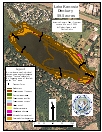Lake Kenosia, Danbury
2004 Aquatic Plant Survey Map of Lake Kenosia
The southwest end of Lake Kenosia is residentially developed, including a large condominium complex. The northwest side is mostly marshland, but a small mobile home park also is located there. The lake’s northeast side has mixed development with residential and industrial property and a park with a city beach. A state boat launch exists at the southeast end of the lake, although gasoline motors are prohibited.
Diversity of aquatic plants in the 59.5-acre Lake Kenosia was found to be relatively low during a 2004 survey, with only nine species recorded. Three of these were invasive plants, although the lake was dominated by a native species, coontail (Ceratophyllum demersum).
Coontail was widespread and dense but did not occur in water more than 12 feet deep; neither did other plants. The maximum depth in the lake is 18 feet, and mean depth is 13 feet. The invasive Eurasian watermilfoil (Myriophyllum spicatum) was found in small to large patches around the lake, and native white water lily (Nymphaea odorata) was found in large mats, primarily in water less than 4 feet deep on the northeast side of the lake. White water lily also was found in smaller patches on the lake’s northwest and southwest sides. Yellow water lily (Nuphar variegata) was found only in small patches in less than 4 feet of water on the northwest and the southwest sides of the lake. The two invasives, curlyleaf pondweed (Potamogeton crispus) and minor naiad (Najas minor), were found in small patches in less than 4 feet of water along the south side of the lake with the native small pondweed (Potamogeton pusillus).
| Species recorded in our 2004 survey of Kenosia Lake. Scientific Names *Invasive Species |
||||
| Coontail | Illinois pondweed | Small pondweed | ||
| Curlyleaf pondweed* | Minor naiad* | White water lily | ||
| Eurasian watermilfoil* | Sago pondweed | Yellow water lily | ||


